1. What are the monocrystalline and multicrystalline solar panels?
Monocrystalline silicon solar cells are manufactured from monocrystalline silicon wafers. In monocrystalline silicon materials, silicon atoms are periodically arranged in an orderly space and have long-range order. This orderliness is conducive to the improvement of the conversion efficiency of solar cells. At present, the conversion efficiency of monocrystalline silicon solar cells is 14%-17%, up to 24%.
Multicrystalline silicon material is a collection of many single crystal particles (particle diameter ranging from a few microns to a few millimeters). The size and crystal orientation of each single crystal particle is different from each other, and the conversion efficiency is about 13% to 15%, up to 20%. Buy mono solar panels now!
2. What is the difference between monocrystalline and multicrystalline solar panels?
The photoelectric conversion rate is different, and the conversion efficiency of monocrystalline solar panels has always been higher than that of multicrystalline solar panels.
The material of monocrystalline solar panels is better than that of multicrystalline, and it is not easy to be damaged during the production process.
In appearance, monocrystalline solar panels are generally monochromatic, while polycrystals have mixed colors, including monochromatic blue. And it also contains colored ones.
Price: monocrystalline solar panels will normally be more expensive than multicrystalline solar panels.
3. Which is better, monocrystalline or multicrystalline solar power panels?
Monocrystalline silicon solar cells have mature production technology and are widely used in aerospace and high-tech products. However, as for jayuansolution.com/" target="_self">solar products manufacturer, the manufacturing process of monocrystalline silicon solar cells is complicated, and the manufacturing requires large energy consumption and high cost.
Multicrystalline silicon solar cells have a shorter production time and lower manufacturing costs than monocrystalline silicon solar cells. In this way, it has an important position in the market. Learn more about the monocrystalline and polycrystalline solar panel difference.




